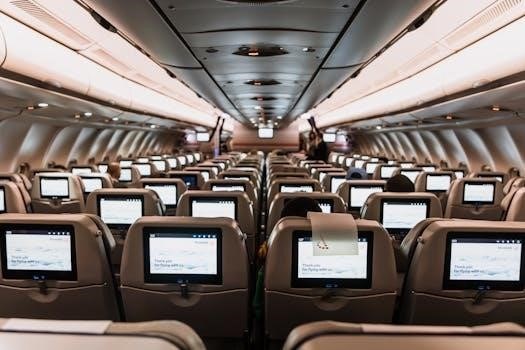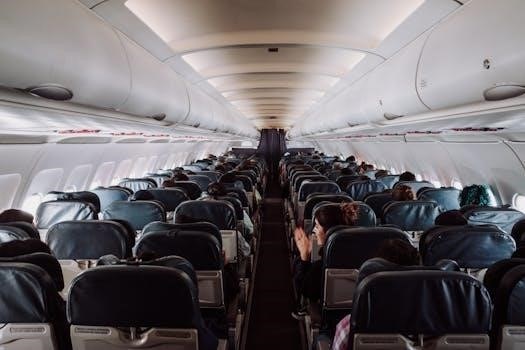Class A CDL Pre-Trip Inspection Overview
The Class A CDL pre-trip inspection is crucial for ensuring vehicle safety and compliance. It involves a thorough examination of the truck and trailer, covering all critical systems. This process is required before every trip to identify potential issues.
Importance of Pre-Trip Inspections
Pre-trip inspections are essential for safe and responsible Class A CDL operation, helping drivers ensure their vehicles are in optimal condition before hitting the road. These inspections help prevent accidents by identifying potential mechanical problems before they can become hazardous. Regular checks reduce the likelihood of breakdowns and costly repairs, saving both time and money for fleet owners and drivers. A detailed pre-trip inspection ensures compliance with federal regulations and avoids penalties. By consistently performing thorough checks, drivers can enhance road safety for themselves and others sharing the road, contributing to safer transportation overall. This also helps in maintaining the vehicle’s longevity and operational efficiency.
Federal Regulations and Compliance
Federal regulations mandate pre-trip inspections for all commercial motor vehicles, including Class A vehicles. These regulations, overseen by the FMCSA, aim to ensure vehicle safety and prevent accidents. Compliance with these rules is not optional; it’s a legal requirement for all CDL holders. Non-compliance can lead to hefty fines, penalties, and even the loss of certifications and licenses; Drivers must be aware of the specific inspection requirements and meticulously follow them. These regulations specify what items should be checked, and how to check them, ensuring a standardized safety process. Adhering to these regulations is crucial for maintaining a safe driving record and legal operation of commercial vehicles.

Pre-Trip Inspection Checklist Components
The checklist includes exterior, engine, brake, lights, and tire inspections. Each component has specific points to verify for safe operation, ensuring comprehensive vehicle assessment. These components must be checked thoroughly.
Exterior Inspection Points
The exterior inspection involves checking for any visible damage or leaks on the body, mirrors, and windows. It is essential to ensure that the bumper is properly secured, not cracked or broken. Inspect all lights, including headlights, turn signals, and clearance lights, for proper function and cleanliness. Verify that reflectors are present and in good condition. Also, check the windshield wipers for proper operation and condition. Additionally, examine the vehicle for any leaning, which could indicate suspension problems. Look at the overall condition of the truck, ensuring there are no obvious issues that could compromise safety. This includes verifying the condition of the mud flaps and ensuring all external components are secure.

Engine Compartment Checks
Within the engine compartment, it’s important to check the air filter housing for secure mounting and proper cover placement. Examine the windshield washer fluid reservoir for any leaks and to ensure it has the correct fluid level. Inspect the turbocharger for any signs of oil or exhaust leaks, ensuring it is operating correctly. Verify that all hoses and belts are in good condition without cracks or excessive wear. Look for any loose wiring or connections that could lead to electrical problems. Check the coolant level and ensure there are no leaks in the cooling system. Also, confirm that all fluid levels are within the acceptable ranges and that there are no unusual sounds or smells coming from the engine.
Brake System Examination
The brake system examination is a critical part of the pre-trip inspection, focusing on both the air brake components and hydraulic systems if applicable. Check the air compressor for proper operation and listen for any unusual noises. Inspect the air lines and hoses for leaks, cracks, or damage. Verify that the air tanks are securely mounted and not damaged, ensuring proper air pressure build-up. Examine the brake chambers and pushrods for excessive wear or damage. Also, inspect the brake drums or rotors, brake pads, and shoes for proper condition and wear. During the examination, ensure the brake pedal has the proper feel and travel, confirming the entire system functions correctly and is safe for operation.
Lights and Reflectors Verification
Verification of lights and reflectors is an essential part of the pre-trip inspection, ensuring visibility and safety. The inspection should include headlights, both high and low beams, verifying they are clean and functioning correctly. Check all turn signals, ensuring proper activation and visibility; Inspect clearance and identification lights for proper color and working order. Brake lights should be examined to confirm they illuminate when the brake pedal is depressed. Reflectors on the vehicle and trailer must be clean and securely mounted. All lights must be free of cracks or other damage, and must be the correct color. Proper functioning ensures safe driving conditions, especially during low light and night hours.
Tires, Wheels, and Rims
The inspection of tires, wheels, and rims is a crucial safety component of the pre-trip. Start by checking tire tread depth, ensuring it meets the required minimum. Inspect tire sidewalls for any bulges, cuts, or signs of damage. Verify that tires are properly inflated according to the manufacturer’s specifications. Examine wheels for cracks, bends, or loose lug nuts. Rims should be free of damage and securely attached. Ensure no foreign objects are lodged between the tires or rims. Proper maintenance of tires, wheels, and rims is vital for safe vehicle operation and preventing potential hazards on the road. Regular checks help to avoid breakdowns.

Performing the Inspection
A systematic approach is essential for performing a thorough pre-trip inspection. This involves following a structured process, ensuring no critical area is overlooked. Consistent practice helps improve efficiency and accuracy.
Step-by-Step Inspection Guide
Begin your inspection at the front of the vehicle, moving systematically around it. Start by checking the engine compartment, ensuring fluid levels are correct and there are no leaks. Next, inspect the lights, making sure they are clean and functioning properly. Examine the tires, wheels, and rims for damage or wear. Then move to the brake system, verifying air pressure and components. Continue around the vehicle, checking suspension parts, fuel tanks, and mirrors. Finally, inspect the trailer, including landing gear, lights, and brakes. Remember to speak clearly, pointing out each item and explaining its condition. Consistent practice will ensure a complete and accurate inspection.
Using a Checklist Effectively
A checklist is an essential tool for a thorough pre-trip inspection. It helps ensure that no critical component is overlooked. Use the checklist methodically, following the order of items listed to optimize your inspection path. Point to each item as you inspect it, verbally stating its condition. A checklist promotes consistency and reduces the chance of missing key details. During practice, use the checklist repeatedly until you are familiar with the process. This will help you master the inspection and allow you to identify potential problems quickly and efficiently. A checklist is a guide, not a substitute for careful examination.
Practice and Memorization
Consistent practice is vital for mastering the Class A pre-trip inspection. Aim for daily practice sessions, going through the entire process from start to finish. Memorize the sequence of checks and the specific items to inspect. This allows for a smoother, more efficient inspection. Repetition builds familiarity and confidence. Practice both with and without a physical checklist to test your knowledge. Verbalizing the inspection process while you practice helps with retention. Consistent practice reinforces the critical steps and observations, ensuring you are prepared for the CDL exam and for real-world scenarios. Memorization combined with practice ensures a comprehensive approach.

Additional Resources
To aid in learning, various tools are available, including smartphone apps, training programs, and buddy systems. These resources provide different learning methods to reinforce inspection procedures and knowledge.
Smartphone Study Apps
Smartphone applications are a great resource for Class A CDL pre-trip inspection preparation. These apps often provide interactive checklists, allowing you to simulate the actual inspection process. Many apps include detailed diagrams and explanations for each inspection point, helping students understand the “why” behind each check. Some apps offer features such as voice prompts, which can be very helpful when learning to verbally explain the inspection process. Furthermore, the portability of these apps allows students to study anywhere, anytime, using their mobile device. These tools can improve memorization and ensure thorough understanding of all inspection components. Some apps even offer free versions, making this method accessible to all students.
Training and Buddy Systems
Effective training programs and the implementation of buddy systems are essential for mastering the Class A CDL pre-trip inspection. Structured training courses typically provide a detailed breakdown of each inspection area, ensuring that students understand all the requirements. The buddy system allows students to practice inspections together, learning from each other’s mistakes and reinforcing the correct procedures. By listening to others and observing different techniques, you can gain a more comprehensive understanding of the process. This collaborative approach enhances memorization and promotes thorough learning of each component. Furthermore, the buddy system adds a layer of accountability and encouragement, improving the overall learning experience. Regular practice with a partner will ensure higher success.
